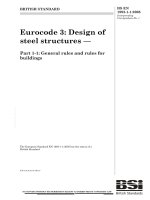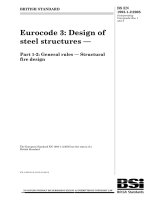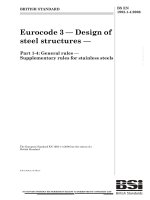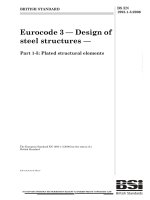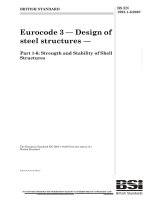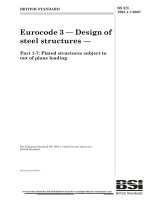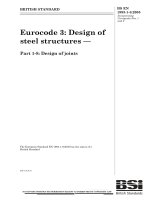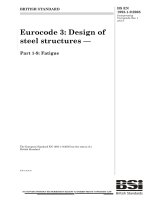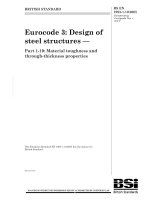Tiêu chuẩn Châu Âu EC9: Kết cấu nhôm phần 1.2: Kết cấu chịu lửa (Eurocode9 BS EN1999 1 2 e 2007 structural fire design Design of aluminum structures part 1.2: Structural fire design)
Bạn đang xem bản rút gọn của tài liệu. Xem và tải ngay bản đầy đủ của tài liệu tại đây (780.13 KB, 64 trang )
BRITISH STANDARD
Eurocode 9 — Design
of aluminium
structures —
Licensed copy:PONTYPRIDD COLLEGE, 12/01/2008, Uncontrolled Copy, © BSI
Part 1-2: Structural fire design
The European Standard EN 1999-1-2:2007 has the status of a
British Standard
ICS 91.010.30; 91.080.10
12 &23<,1* :,7+287 %6, 3(50,66,21 (;&(37 $6 3(50,77(' %< &23<5,*+7 /$:
BS EN
1999-1-2:2007
BS EN 1999-1-2:2007
National foreword
This British Standard was published by BSI. It is the UK implementation of
EN 1999-1-2:2007. It supersedes DD ENV 1999-1-2:2000, which will be
withdrawn on 31 March 2010.
The structural Eurocodes are divided into packages by grouping Eurocodes for
each of the main materials, concrete, steel, composite concrete and steel,
timber, masonry and aluminium, this is to enable a common date of
withdrawal (DOW) for all the relevant parts that are needed for a particular
design. The conflicting national standards will be withdrawn at the end of the
coexistence period, after all the EN Eurocodes of a package are available.
Following publication of the EN, there is a period allowed for national
calibration during which the national annex is issued, followed by a further
coexistence period of a maximum 3 years. During the coexistence period
Member States will be encouraged to adapt their national provisions to
withdraw conflicting national rules before the end of the coexistent period in
March 2010.
Licensed copy:PONTYPRIDD COLLEGE, 12/01/2008, Uncontrolled Copy, © BSI
At the end of this coexistence period, the national standard(s) will be
withdrawn.
In the UK, the following national standards are superseded by the Eurocode 9
series. These standards will be withdrawn on a date to be announced.
Eurocode
Superseded British Standards
EN 1999-1-1
BS 8118-2:1991 Structural use of aluminium. Specification
for materials, workmanship and protection (superseded).
DD ENV 1999-1-1:2000 Eurocode 9. Design of aluminium
structures. General rules. General rules and rules for
buildings (superseded).
BS 8118-1:1991 Structural use of aluminium. Code of practice
for design (partially superseded).
EN 1999-1-2
DD ENV 1999-1-2 Design of aluminium structures. General
rules. Structural fire design (superseded).
EN 1999-1-3
DD ENV 1999-2:2000 Eurocode 9. Design of aluminium
structures. Structures susceptible to fatigue (superseded).
BS 8118-1:1991 Structural use of aluminium. Code of practice
for design (partially superseded).
This British Standard was
published under the authority
of the Standards Policy and
Strategy Committee
on 30 April 2007
© BSI 2007
ISBN 978 0 580 50415 0
EN 1999-1-4
BS 8118-1:1991 Structural use of aluminium. Code of practice
for design (partially superseded).
EN 1999-1-5
None
Amendments issued since publication
Amd. No.
Date
Comments
BS EN 1999-1-2:2007
The UK participation in its preparation was entrusted by Technical Committee
B/525, Building and civil engineering structures, to Subcommittee B/525/9,
Structural use of aluminium.
A list of organizations represented on B/525/9 can be obtained on request to its
secretary.
Where a normative part of this EN allows for a choice to be made at the national
level, the range and possible choice will be given in the normative text, and a note
will qualify it as a Nationally Determined Parameter (NDP). NDPs can be a
specific value for a factor, a specific level or class, a particular method or a
particular application rule if several are proposed in the EN.
To enable EN 1999 to be used in the UK, the NDPs will be published in a
National Annex, which will be made available by BSI in due course, after public
consultation has taken place.
This publication does not purport to include all the necessary provisions of a
contract. Users are responsible for its correct application.
Licensed copy:PONTYPRIDD COLLEGE, 12/01/2008, Uncontrolled Copy, © BSI
Compliance with a British Standard cannot confer immunity from legal
obligations.
i
Licensed copy:PONTYPRIDD COLLEGE, 12/01/2008, Uncontrolled Copy, © BSI
blank
EUROPEAN STANDARD
EN 1999-1-2
NORME EUROPÉENNE
EUROPÄISCHE NORM
February 2007
ICS 91.010.30; 91.080.10
Supersedes ENV 1999-1-2:1998
English Version
Eurocode 9 - Design of aluminium structures - Part 1-2:
Structural fire design
Licensed copy:PONTYPRIDD COLLEGE, 12/01/2008, Uncontrolled Copy, © BSI
Eurocode 9 - Calcul des structures en aluminium - Partie 12: Calcul du comportement au feu
Eurocode 9 - Bemessung und Konstruktion von
Aluminiumtragwerken - Teil 1-2: Tragwerksbemessung für
den Brandfall
This European Standard was approved by CEN on 18 September 2006.
CEN members are bound to comply with the CEN/CENELEC Internal Regulations which stipulate the conditions for giving this European
Standard the status of a national standard without any alteration. Up-to-date lists and bibliographical references concerning such national
standards may be obtained on application to the CEN Management Centre or to any CEN member.
This European Standard exists in three official versions (English, French, German). A version in any other language made by translation
under the responsibility of a CEN member into its own language and notified to the CEN Management Centre has the same status as the
official versions.
CEN members are the national standards bodies of Austria, Belgium, Bulgaria, Cyprus, Czech Republic, Denmark, Estonia, Finland,
France, Germany, Greece, Hungary, Iceland, Ireland, Italy, Latvia, Lithuania, Luxembourg, Malta, Netherlands, Norway, Poland, Portugal,
Romania, Slovakia, Slovenia, Spain, Sweden, Switzerland and United Kingdom.
EUROPEAN COMMITTEE FOR STANDARDIZATION
COMITÉ EUROPÉEN DE NORMALISATION
EUROPÄISCHES KOMITEE FÜR NORMUNG
Management Centre: rue de Stassart, 36
© 2007 CEN
All rights of exploitation in any form and by any means reserved
worldwide for CEN national Members.
B-1050 Brussels
Ref. No. EN 1999-1-2:2007: E
EN 1999-1-2:2007 (E)
Contents
Page
Licensed copy:PONTYPRIDD COLLEGE, 12/01/2008, Uncontrolled Copy, © BSI
Foreword..............................................................................................................................................................4
1
1.1
1.1.1
1.1.2
1.2
1.3
1.4
1.5
1.5.1
1.5.2
1.5.3
1.5.4
1.5.5
1.6
General..................................................................................................................................................10
Scope ....................................................................................................................................................10
Scope of EN 1999.................................................................................................................................10
Scope of EN 1999-1-2 ..........................................................................................................................10
Normative references ..........................................................................................................................11
Assumptions ........................................................................................................................................11
Distinction between principles and application rules......................................................................11
Terms and definitions .........................................................................................................................12
Special terms relating to design in general ......................................................................................12
Terms relating to thermal actions ......................................................................................................12
Terms relating to material and products ...........................................................................................12
Terms relating to heat transfer analysis ...........................................................................................12
Terms relating to mechanical behaviour analysis ...........................................................................13
Symbols ................................................................................................................................................13
2
2.1
2.1.1
2.1.2
2.1.3
2.2
2.3
2.4
2.4.1
2.4.2
2.4.3
2.4.4
Basis of design ....................................................................................................................................15
Requirements .......................................................................................................................................15
Basic requirements..............................................................................................................................15
Nominal fire exposure .........................................................................................................................15
Parametric fire exposure.....................................................................................................................16
Actions..................................................................................................................................................16
Design values of material properties.................................................................................................16
Verification methods ...........................................................................................................................16
General..................................................................................................................................................16
Member analysis ..................................................................................................................................17
Analysis of part of the structure ........................................................................................................18
Global structural analysis...................................................................................................................19
3
3.1
3.2
3.2.1
3.2.2
3.3
3.3.1
3.3.2
Material .................................................................................................................................................19
General..................................................................................................................................................19
Mechanical properties of aluminium alloys ......................................................................................19
Strength and deformation properties ................................................................................................19
Unit mass..............................................................................................................................................22
Thermal properties ..............................................................................................................................22
Aluminium alloys .................................................................................................................................22
Fire protection materials.....................................................................................................................24
4
4.1
4.2
4.2.1
4.2.2
4.2.3
4.3
4.3.1
4.3.2
4.3.3
4.3.4
Structural fire design...........................................................................................................................24
General..................................................................................................................................................24
Simple calculation models..................................................................................................................25
General..................................................................................................................................................25
Resistance ............................................................................................................................................25
Aluminium temperature development ...............................................................................................28
Advanced calculation models ............................................................................................................34
General..................................................................................................................................................34
Thermal response ................................................................................................................................35
Mechanical response ..........................................................................................................................35
Validation of advanced calculation models ......................................................................................36
Annex A (informative) Properties of aluminium alloys and/or tempers not listed in EN 1999-1-1..........37
Annex B (informative) Heat transfer to external structural aluminium members.......................................38
B.1
General..................................................................................................................................................38
2
EN 1999-1-2:2007 (E)
Licensed copy:PONTYPRIDD COLLEGE, 12/01/2008, Uncontrolled Copy, © BSI
B.1.1
B.1.2
B.1.3
B.1.4
B.2
B.2.1
B.2.2
B.2.3
B.2.4
B.3
B.3.1
B.3.2
B.3.3
B.3.4
B.4
B.5
B.5.1
B.5.2
B.5.3
Basis .....................................................................................................................................................38
Conventions for dimensions ..............................................................................................................38
Heat balance ........................................................................................................................................38
Overall configuration factors .............................................................................................................40
Column not engulfed in flame ............................................................................................................41
Radiative heat transfer........................................................................................................................41
Flame emissivity..................................................................................................................................42
Flame temperature ..............................................................................................................................46
Flame absorptivity...............................................................................................................................47
Beam not engulfed in flame................................................................................................................47
Radiative heat transfer........................................................................................................................47
Flame emissivity..................................................................................................................................49
Flame temperature ..............................................................................................................................50
Flame absorptivity...............................................................................................................................50
Column engulfed in flame...................................................................................................................50
Beam fully or partially engulfed in flame ..........................................................................................53
Radiative heat transfer........................................................................................................................53
Flame emissivity..................................................................................................................................57
Flame absorptivity...............................................................................................................................57
3
EN 1999-1-2:2007 (E)
Foreword
This European Standard (EN 1999-1-2:2007) has been prepared by Technical Committee CEN/TC 250
“Structural Eurocodes”, the secretariat of which is held by BSI.
This European Standard shall be given the status of a national standard, either by publication of an identical
text or by endorsement, at the latest by August 2007, and conflicting national standard shall be withdrawn at
the latest by March 2010.
This European Standard supersedes ENV 1999-1-2:1998
Licensed copy:PONTYPRIDD COLLEGE, 12/01/2008, Uncontrolled Copy, © BSI
CEN/TC 250 is responsible for all Structural Eurocodes
According to the CEN/CENELEC Internal Regulations, the national standards organizations of the following
countries are bound to implement this European Standard: Austria, Belgium, Bulgaria, Cyprus, Czech
Republic, Denmark, Estonia, Finland, France, Germany, Greece, Hungary, Iceland, Ireland, Italy, Latvia,
Lithuania, Luxembourg, Malta, Netherlands, Norway, Poland, Portugal, Romania, Slovakia, Slovenia, Spain,
Sweden, Switzerland and United Kingdom.
Background of the Eurocode programme
In 1975, the Commission of the European Community decided on an action programme in the field of
construction, based on article 95 of the Treaty. The objective of the programme was the elimination of
technical obstacles to trade and the harmonisation of technical specifications.
Within this action programme, the Commission took the initiative to establish a set of harmonised technical
rules for the design of construction works which, in a first stage, would serve as an alternative to the national
rules in force in the Member States and, ultimately, would replace them.
For fifteen years, the Commission, with the help of a Steering Committee with Representatives of Member
States, conducted the development of the Eurocodes programme, which led to the first generation of
European codes in the 1980s.
1
In 1989, the Commission and the Member States of the EU and EFTA decided, on the basis of an agreement
between the Commission and CEN, to transfer the preparation and the publication of the Eurocodes to the
CEN through a series of Mandates, in order to provide them with a future status of European Standard (EN).
This links de facto the Eurocodes with the provisions of all the Council’s Directives and/or Commission’s
Decisions dealing with European standards (e.g. the Council Directive 89/106/EEC on construction products CPD - and Council Directives 93/37/EEC, 92/50/EEC and 89/440/EEC on public works and services and
equivalent EFTA Directives initiated in pursuit of setting up the internal market).
The Structural Eurocode programme comprises the following standards generally consisting of a number of
Parts:
EN 1990
Eurocode 0:
Basis of Structural Design
EN 1991
Eurocode 1:
Actions on structures
1
Agreement between the Commission of the European Communities and the European Committee for Standardisation (CEN) concerning
the work on EUROCODES for the design of building and civil engineering works (BC/CEN/03/89).
4
EN 1999-1-2:2007 (E)
EN 1992
Eurocode 2:
Design of concrete structures
EN 1993
Eurocode 3:
Design of steel structures
EN 1994
Eurocode 4:
Design of composite steel and concrete structures
EN 1995
Eurocode 5:
Design of timber structures
EN 1996
Eurocode 6:
Design of masonry structures
EN 1997
Eurocode 7:
Geotechnical design
EN 1998
Eurocode 8:
Design of structures for earthquake resistance
EN 1999
Eurocode 9:
Design of aluminium structures
Licensed copy:PONTYPRIDD COLLEGE, 12/01/2008, Uncontrolled Copy, © BSI
Eurocode standards recognise the responsibility of regulatory authorities in each Member State and have
safeguarded their right to determine values related to regulatory safety matters at national level where these
continue to vary from State to State.
Status and field of application of Eurocodes
The Member States of the EU and EFTA recognise that Eurocodes serve as reference documents for the
following purposes:
.
as a means to prove compliance of building and civil engineering works with the essential requirements of
Council Directive 89/106/EEC, particularly Essential Requirement No.1 – Mechanical resistance and
stability, and Essential Requirement No 2 – Safety in case of fire
.
as a basis for specifying contracts for the execution of construction works and related engineering
services
.
as a framework for drawing up harmonised technical specifications for construction products (En’s and
ETA’s)
The Eurocodes, as far as they concern the construction works themselves, have a direct relationship with the
2
Interpretative Documents referred to in Article 12 of the CPD, although they are of a different nature from
3
harmonised product standards . Therefore, technical aspects arising from the Eurocodes work need to be
adequately considered by CEN Technical Committees and/or EOTA Working Groups working on product
standards with a view to achieving full compatibility of these technical specifications with the Eurocodes.
The Eurocode standards provide common structural design rules for everyday use for the design of whole
structures and component products of both a traditional and an innovative nature. Unusual forms of
construction or design conditions are not specifically covered and additional expert consideration will be
required by the designer in such cases.
2
3
According to Art. 3.3 of the CPD, the essential requirements (ERs) shall be given concrete form in interpretative documents for the
creation of the necessary links between the essential requirements and the mandates for harmonised ENs and ETAGs/ETAs.
According to Art. 12 of the CPD the interpretative documents shall :
a)
give concrete form to the essential requirements by harmonising the terminology and the technical bases and indicating classes or levels for
each requirement where necessary ;
b) indicate methods of correlating these classes or levels of requirement with the technical specifications, e.g. methods of calculation and of proof,
technical rules for project design, etc. ;
c) serve as a reference for the establishment of harmonised standards and guidelines for European technical approvals.
The Eurocodes, de facto, play a similar role in the field of the ER 1 and a part of ER 2.
5
EN 1999-1-2:2007 (E)
National standards implementing Eurocodes
The National Standards implementing Eurocodes will comprise the full text of the Eurocode (including any
Annexes), as published by CEN, which may be preceded by a National title page and National foreword, and
may be followed by a National Annex (informative).
Licensed copy:PONTYPRIDD COLLEGE, 12/01/2008, Uncontrolled Copy, © BSI
The National Annex (informative) may only contain information on those parameters which are left open in the
Eurocode for national choice, known as Nationally Determined Parameters, to be used for the design of
buildings and civil engineering works to be constructed in the country concerned, i.e.:
.
values for partial factors and/or classes where alternatives are given in the Eurocode;
.
values to be used where a symbol only is given in the Eurocode;
.
geographical and climatic data specific to the Member State, e.g. snow map;
.
the procedure to be used where alternative procedures are given in the Eurocode;
.
references to non-contradictory complementary information to assist the user to apply the Eurocode.
Links between Eurocodes and harmonised technical specifications (EN’s and ETA’s) for products
There is a need for consistency between the harmonised technical specifications for construction products
4
and the technical rules for works . Furthermore, all the information accompanying the CE Marking of the
construction products which refer to Eurocodes shall clearly mention which Nationally Determined Parameters
have been taken into account.
Additional information specific to EN 1999-1-2
EN 1999-1-2 describes the principles, requirements and rules for the structural design of buildings exposed to
fire, including the following aspects.
Safety requirements
EN 1999-1-2 is intended for owners of construction works (e.g. for the formulation of their specific
requirements), designers, contractors and relevant authorities.
The general objectives of fire protection are to limit risks with respect to the individual and society,
neighbouring property, and where required, environment or directly exposed property, in the case of fire.
Construction Products Directive 89/106/EEC gives the following essential requirement for the limitation of fire
risks:
"The construction works must be designed and build in such a way, that in the event of an outbreak of fire
.
the load bearing resistance of the construction can be assumed for a specified period of time;
.
the generation and spread of fire and smoke within the works are limited;
.
the spread of fire to neighbouring construction works is limited;
4
see Art.3.3 and Art.12 of the CPD, as well as clauses 4.2, 4.3.1, 4.3.2 and 5.2 of ID 1.
6
EN 1999-1-2:2007 (E)
.
the occupants can leave the works or can be rescued by other means;
.
the safety of rescue teams is taken into consideration".
According to the Interpretative Document N° 2 "Safety in case of fire5" the essential requirement may be
observed by following various possibilities for fire safety strategies prevailing in the Member States like
conventional fire scenarios (nominal fires) or "natural" (parametric) fire scenarios, including passive and/or
active fire protection measures.
The fire parts of Structural Eurocodes deal with specific aspects of passive fire protection in terms of
designing structures and parts thereof for adequate load bearing resistance and for limiting fire spread as
relevant.
Required functions and levels of performance can be specified either in terms of nominal (standard) fire
resistance rating, generally given in national fire regulations or by referring to fire safety engineering for
assessing passive and active measures.
Licensed copy:PONTYPRIDD COLLEGE, 12/01/2008, Uncontrolled Copy, © BSI
Supplementary requirements concerning, for example
.
the possible installation and maintenance of sprinkler systems;
.
conditions on occupancy of building or fire compartment;
.
the use of approved insulation and coating materials, including their maintenance.
are not given in this document, because they are subject to specification by the competent authority.
Numerical values for partial factors and other reliability elements are given as recommended values that
provide an acceptable level of reliability. They have been selected assuming that an appropriate level of
workmanship and of quality management applies.
Design procedures
A full analytical procedure for structural fire design would take into account the behaviour of the structural
system at elevated temperatures, the potential heat exposure and the beneficial effects of active and passive
fire protection systems, together with the uncertainties associated with these three features and the
importance of the structure (consequences of failure).
At the present time it is possible to undertake a procedure for determining adequate performance which
incorporates some, if not all, of these parameters and to demonstrate that the structure, or its components, will
give adequate performance in a real building fire. However, where the procedure is based on a nominal
(standard) fire the classification system, which call for specific periods of fire resistance, takes into account
(though not explicitly), the features and uncertainties described above.
The design procedure for structural fire design is illustrated in Figure 0.1. The prescriptive approach and the
performance-based approach are identified. The prescriptive approach uses nominal fires to generate thermal
actions. The performance-based approach, using fire safety engineering, refers to thermal actions based on
physical and chemical parameters.
NOTE
Tabulated data, as shown in Figure 0.1, are not available for aluminium components.
For design according to this part, EN 1991-1-2 is required for the determination of thermal and mechanical
actions to the structure.
5 see clause 2.2, 3.2(4) and 4.2.3.3
7
EN 1999-1-2:2007 (E)
Design aids
It is expected, that design aids based on the calculation models given in EN 1999-1-2, will be prepared by
interested external organizations.
The main text of EN 1999-1-2 together with normative Annexes includes most of the principal concepts and
rules necessary for structural fire design of aluminium structures.
National Annex for EN 1999-1-2
This standard gives alternative procedures, values and recommendations for classes with notes indicating
where national choices may have to be made. Therefore the National Standard implementing EN 1999-1-2
should have a National Annex containing the Eurocode all Nationally Determined Parameters to be used for
the design of buildings and civil engineering works to be constructed in the relevant country.
National choice is allowed in EN 1999-1-2 through clauses:
Licensed copy:PONTYPRIDD COLLEGE, 12/01/2008, Uncontrolled Copy, © BSI
2.3 (1)
2.3 (2)
2.4.2 (3)
4.2.2.1 (1)
4.2.2.3 (5)
4.2.2.4 (5)
8
Licensed copy:PONTYPRIDD COLLEGE, 12/01/2008, Uncontrolled Copy, © BSI
EN 1999-1-2:2007 (E)
Project Design
Performance-Based Code
(Physically based Thermal Actions)
Prescriptive Rules
(Thermal Actions given by Nominal Fire)
Tabulated
Data
Selection of Simple or Advanced
Fire Development Models
Member
Analysis
Analysis of Part
of the Structure
Analysis of
Entire Structure
Calculation of
Mechanical Actions
at Boundaries
Calculation of
Mechanical Actions
at Boundaries
Selection of
Mechanical
Actions
Member
Analysis
Analysis of
Part of the
Structure
Analysis of
Entire
Structure
Advanced
Calculation
Models
Calculation of
Mechanical
Actions
at Boundaries
Calculation of
Mechanical
Actions
at Boundaries
Selection of
Mechanical
Actions
Advanced
Calculation
Models
Advanced
Calculation
Models
Simple
Calculation
Models
Advanced
Calculation
Models
Simple
Calculation
Models
(if available)
Advanced
Calculation
Models
SimpleCalculation
Models
(if available)
Advanced
Calculation
Models
Figure 0.1 – A general illustration of the design procedure for structural fire design
9
EN 1999-1-2:2007 (E)
1
General
1.1
Scope
1.1.1
Scope of EN 1999
(1)P EN 1999 applies to the design of buildings and civil engineering works in aluminium. It complies with the
principles and requirements for the safety and serviceability of structures, the basis of their design and
verification that are given in EN 1990 – Basis of structural design.
(2)P EN 1999 is only concerned with requirements for resistance, serviceability, durability and fire resistance
of aluminium structures. Other requirements, e.g. concerning thermal or sound insulation, are not considered.
Licensed copy:PONTYPRIDD COLLEGE, 12/01/2008, Uncontrolled Copy, © BSI
(3) EN 1999 is intended to be used in conjunction with:
.
EN 1990 “Basis of structural design”
.
EN 1991 “Actions on structures”, all relevant parts
.
European Standards for construction products relevant for aluminium structures
.
EN 1998 “Design of structures for earthquake resistance”, where aluminium structures are built in seismic
regions
(4) EN 1999 is subdivided in five parts:
.
EN 1999-1-1 Design of aluminium structures: General structural rules
.
EN 1999-1-2 Design of aluminium structures: Structural fire design
.
EN 1999-1-3 Design of aluminium structures: Structures susceptible to fatigue
.
EN 1999-1-4 Design of aluminium structures: Cold formed structural sheeting
.
EN 1999-1-5 Design of aluminium structures: Shell structures
1.1.2
Scope of EN 1999-1-2
(1) EN 1999-1-2 deals with the design of aluminium structures for the accidental situation of fire exposure
and is intended to be used in conjunction with EN 1999-1-1 and EN 1991-1-2. EN1999-1-2 only identifies
differences from, or supplements to, normal temperature design.
(2) EN 1999-1-2 deals only with passive methods of fire protection. Active methods are not covered.
(3) EN 1999-1-2 applies to aluminium structures that are required to fulfil load bearing function if exposed to
fire, in terms of avoiding premature collapse of the structure.
NOTE
This part does not include rules for separating elements.
(4) EN 1999-1-2 gives principles and application rules for design of structures for specified requirements in
respect of the load bearing function and the levels of performance.
(5) EN 1999-1-2 applies to structures, or parts of structures, that are within the scope of EN 1999-1-1 and are
designed accordingly.
(6) The aluminium alloy properties given in the Part 1-2 of EN 1999 apply to the following aluminium alloys:
10
EN 1999-1-2:2007 (E)
EN AW-3004 – H34
EN AW-5083 – O and H12
EN AW-6063 – T5 and T6
EN AW-5005 – O and H34
EN AW-5454 – O and H34
EN AW-6082 – T4 and T6
EN AW-5052 – H34
EN AW-6061 – T6
(7) The methods given in EN 1999-1-2 are applicable also to the other aluminium alloy/tempers of EN 19991-1 if reliable material properties at elevated temperatures are available or the simplified assumptions in 3.2.1
are applied.
1.2
Normative references
Licensed copy:PONTYPRIDD COLLEGE, 12/01/2008, Uncontrolled Copy, © BSI
(1) This European Standard incorporates by dated or undated reference, provisions from other publications.
These normative references are cited at the appropriate places in the text and the publications are listed
hereafter. For dated references, subsequent amendments to or revisions of any of these publications apply to
this European Standard only if incorporated in it by amendment or revision. For undated references the latest
edition of the publication referred to applies (including amendments).
EN 485-2
Aluminium and aluminium alloys. Sheet, strip and plate. Part 2: Mechanical properties
EN 755-2
Aluminium and aluminium alloys. Extruded rod/bar, tube and profiles. Part 2: Mechanical
properties
EN 1990
Basis of structural design
EN 1991-1-2
Basis of design and actions on structures Part 1-2: Actions on structures exposed to fire
EN 1999-1-1
Design of aluminium structures: Part 1-1: General structural rules
EN 1090-36
Execution of steel structures and aluminium structures – Part 3: Technical requirements for
aluminium structures
EN 13501-2
Fire classification of construction products and building elements. Part 2 Classification
using data from fire resistance tests
ENV 13381-1
Fire tests on elements of building construction: Part 1: Test method for determining the
contribution to the fire resistance of structural members: By horizontal protective membranes
ENV 13381-2
Fire tests on elements of building construction. Part 2: Test method for determining the
contribution to the fire resistance of structural members: By vertical protective membranes.
ENV 13381-4
Fire tests on elements of building construction. Part 4: Test method for determining the
contribution to the fire resistance of structural members: By applied protection to steel
structural elements.
1.3
Assumptions
(1) In addition to the general assumptions of EN 1990 the following assumption applies:
Any passive fire protection systems taken into account in the design will be adequately maintained.
1.4
Distinction between principles and application rules
(1) The rules given in EN 1990 1.4 apply.
6 to be published
11
EN 1999-1-2:2007 (E)
1.5
Terms and definitions
(1) The rules in EN 1990 1.5 apply.
(2) The following terms are used in EN 1999-1-2 with the following meanings:
1.5.1
Special terms relating to design in general
1.5.1.1
part of structure
isolated part of an entire structure with appropriate support and boundary conditions
1.5.1.2
protected members
members for which measures are taken to reduce the temperature rise in the member due to fire
Licensed copy:PONTYPRIDD COLLEGE, 12/01/2008, Uncontrolled Copy, © BSI
1.5.2
Terms relating to thermal actions
1.5.2.1
standard temperature-time curve
a nominal curve, defined in EN 13501-2 for representing a model of a fully developed fire in a compartment
1.5.2.2
temperature-time curves
gas temperature in the environment of member surfaces as a function of time. They may be:
.
nominal: Conventional curves, adopted for classification or verification of fire resistance, e.g. the
standard temperature-time curve, external fire curve, hydrocarbon fire curve;
.
parametric: Determined on the basis of fire models and the specific physical parameters defining the
conditions in the fire compartment
1.5.3
Terms relating to material and products
1.5.3.1
fire protection material
any material or combination of materials applied to a structural member for the purpose of increasing its fire
resistance
1.5.4
Terms relating to heat transfer analysis
1.5.4.1
configuration factor
the configuration factor for radiative heat transfer from surface A to surface B is defined as the fraction of
diffusely radiated energy leaving surface A that is incident on surface B
1.5.4.2
convective heat transfer coefficient
convective heat flux to the member related to the difference between the bulk temperature of gas bordering
the relevant surface of the member and the temperature of that surface
1.5.4.3
emissivity
equal to absorptivity of a surface, i.e. the ratio between the radiative heat absorbed by a given surface, and
that of a black body surface
12
EN 1999-1-2:2007 (E)
1.5.4.4
net heat flux
energy per unit time and surface area definitely absorbed by members
1.5.4.5
resulting emissivity
the ratio between the actual radiative heat flux to the member and the net heat flux that would occur if the
member and its radiative environment were considered as black bodies
1.5.4.6
section factor
for an aluminium member, the ratio between the exposed surface area and the volume of aluminium; for an
enclosed member, the ratio between the internal surface area of the exposed encasement and the volume of
aluminium
Licensed copy:PONTYPRIDD COLLEGE, 12/01/2008, Uncontrolled Copy, © BSI
1.5.4.7
box value of section factor
ratio between the exposed surface area of a notional bounding box for the section to the volume of aluminium
1.5.5
Terms relating to mechanical behaviour analysis
1.5.5.1
critical temperature of a structural aluminium member
for a given load level, the temperature at which failure is expected to occur in a structural aluminium member
for a uniform temperature distribution
1.5.5.2
effective 0,2 % proof strength
for a given temperature, the stress level at which the stress-strain relationship of aluminium gives a 0,2 %
permanent strain
1.5.5.3
external member
structural member located outside the building that can be exposed to fire through openings in the building
enclosure
1.6
Symbols
(1) For the purpose of EN 1999-1-2, the following symbols apply in addition to those given in EN 1999-1-1:
Latin upper case letters
Am
the exposed surface area of a member per unit length
Ap
the area of the inner surface of the fire protection material per unit length of the member
Eal
the modulus of elasticity of aluminium for normal temperature design
Eal,.
the modulus of elasticity for aluminium at elevated temperature, . al
V
the volume of a member per unit length
Latin lower case letters
cal
the specific heat of aluminium
cp
the specific heat of the fire protection material
13
Licensed copy:PONTYPRIDD COLLEGE, 12/01/2008, Uncontrolled Copy, © BSI
EN 1999-1-2:2007 (E)
dp
the thickness of fire protection material
fo,θ
the effective 0,2 % proof strength at elevated temperature, θal
h& net,d
the design value of the net heat flux per unit area
Iz
is the radiative heat flux from the flame to beam face
k.
the reduction factor of a strength property of aluminium at elevated temperature, θal
ko,.
the strength reduction factor for the 0,2 proof strength at elevated temperature
ko,. max
the strength reduction factor for the 0,2 proof strength at the maximum aluminium temperature
l
the length at 20 ºC
t
the time in fire exposure
Greek upper case letters
.t
the time interval
Greek lower case letters
. M,fi
the partial safety factor for the relevant material property for the fire situation
.
the reduction factor for design load level in the fire situation
fi
.
the temperature in °C
. al
the aluminium temperature
εm
the surface emissivity of the component
.
the adaptation factor
. al
the thermal conductivity of aluminium
.p
the thermal conductivity of the fire protection material
∝0
the degree of utilisation at time t = 0
. al
the density of aluminium
.p
the density of the fire protection material
14
EN 1999-1-2:2007 (E)
2
Basis of design
2.1
Requirements
2.1.1
Basic requirements
(1)P Where mechanical resistance in the case of fire is required, aluminium structures shall be designed and
constructed in such a way that they maintain their load bearing function during the relevant fire exposurecriterion R.
Licensed copy:PONTYPRIDD COLLEGE, 12/01/2008, Uncontrolled Copy, © BSI
(2)P Where compartmentation is required, the respective members shall be designed and constructed in such
a way, that they maintain their separating function during the relevant fire exposure, i.e.:
.
no integrity failure due to cracks, holes or other openings, which are large enough to cause fire
penetration by hot gases or flames - criterion E;
.
no insulation failure due to temperatures of the non-exposed surface exceeding ignition temperatures criterion I.
(3) Criterion I may be assumed to be met where the average temperature rise during the standard fire
exposure at the non-exposed surface does not exceed 140 ºC and the maximum rise at any point on the nonexposed surface does not exceed 180 ºC.
(4)P Members shall comply with criteria R, E, I as follows:
.
separating only: E and I;
.
load bearing only: R;
.
separating and load bearing: R, E and I.
NOTE
EN 1999-1-2 deals only with the R - criterion. The material properties given in this standard may be used
when calculating temperatures for the I - criterion.
(5) Deformation criteria should be applied where the protection aims, or the design criteria for separating
elements, require consideration of the deformation of the load bearing structure.
(6)
Except from (5), consideration of the deformation of the load bearing structure is not necessary in the
following cases, as relevant:
.
the efficiency of the means of protection has been evaluated according to section 3.3.2;
.
the separating components have to fulfil requirements according to a nominal fire exposure.
2.1.2
(1)
.
Nominal fire exposure
For the standard fire exposure, members should comply with criteria R as follows:
load bearing only: Mechanical resistance (criterion R).
(2)
Criterion R is assumed to be satisfied where the load bearing function is maintained during the required
time of fire exposure.
(3)
With the hydrocarbon fire exposure curve the same criteria should apply, however the reference to this
specific curve should be identified by the letters HC.
15
EN 1999-1-2:2007 (E)
2.1.3
Parametric fire exposure
(1)
The load-bearing function is ensured if collapse is prevented during the complete duration of the fire
including the decay phase or during a required period of time.
2.2
Actions
(1) The thermal and mechanical actions should be taken from EN 1991-1-2.
(2) The values of h& net,d should be obtained from EN 1991-1-2 using:
ε m = 0,3
for clean uncovered surfaces and
ε m = 0,7
for painted and covered (e.g. sooted) surfaces,
Licensed copy:PONTYPRIDD COLLEGE, 12/01/2008, Uncontrolled Copy, © BSI
2.3
Design values of material properties
(1) Design values of mechanical material properties Xfi,d are defined as follows:
Xfi,d = k. Xk / . M,fi
(2.1)
where
Xk is the characteristic value of a strength or deformation property (generally fk or Ek) for normal
temperature design according to EN 1999-1-1
Xk,. is the value of a material property in fire design, generally dependent on the material temperature,
see section 3
k. is the reduction factor for a strength or deformation property (Xk,. / Xk), dependent on the material
temperature, see section 3
NOTE
For mechanical properties of aluminium, the partial safety factor for the fire situation see National Annex. The
use of . M,fi = 1.0 is recommended.
(2) Design values of thermal material properties Xfi,d are defined as follows:
.
.
if an increase of the property is favourable for safety:
Xfi,d = Xk,θ / . M,fi
(2.2a)
if an increase of the property is unfavourable for safety:
Xfi,d = . M,fi Xk,.
(2.2b)
NOTE
For thermal properties of aluminium, the partial safety factor for the fire situation see National Annex. The use
of . M,fi = 1,0 is recommended.
2.4
2.4.1
Verification methods
General
(1)P The model of the structural system adopted for design to EN1999-1-2 shall reflect the expected
performance of the structure in fire.
NOTE
clauses.
16
Where rules given in EN1999-1-2 are valid only for the standard fire exposure, this is identified in the relevant
EN 1999-1-2:2007 (E)
(2)P It shall be verified that, during the relevant duration of fire exposure t:
Efi,d = Rfi,d,t
(2.3)
where
Efi,d is the design effect of actions for the fire situation, determined in accordance with EN 1991-1-2,
including the effects of thermal expansions and deformations
Rfi,d,t is the corresponding design resistance in the fire situation
(3) The structural analysis for the fire situation should be carried out according to EN 1990, 5.1.4 (2).
NOTE 1
For member analysis, see 2.4.2. For analysis of parts of the structure, see 2.4.3. For global structural analysis,
see 2.4.4.
Licensed copy:PONTYPRIDD COLLEGE, 12/01/2008, Uncontrolled Copy, © BSI
NOTE 2
For verifying standard fire resistance requirements, a member analysis is sufficient.
(4) As an alternative to design by calculation, fire design may be based on the results of fire tests, or on fire
tests in combination with calculations.
2.4.2
Member analysis
(1) The effect of actions should be determined for time t = 0 using combination factors .
EN 1991-1-2 clause 4.3.1.
1,1 or
.
2,1 according
to
(2) As a simplification to (1), the effect of actions Efi,d may be obtained from a structural analysis for normal
temperature design as:
Efi,d = . fi Ed
(2.4)
where
Ed is the design value of the corresponding force or moment for normal temperature design, for a
fundamental combination of actions (see EN 1990)
(3) The reduction factor . fi for load combination (6.10) in EN 1990 should be taken as:
.
fi
=
G k + . fi Q k,1
. G G k + . Q,1Q k,1
(2.5)
or for load combination (6.10a) and (6.10b) in EN 1990 as the smaller value given by the two following
expressions:
.
fi
=
G k + . fi Q k,1
. G Gk + . Q,1Q k,1
(2.5a)
.
fi
=
Gk + . fi Qk,1
.. G Gk + . Q,1Q k,1
(2.5b)
where
Qk,1 is the principal variable load
Gk is the characteristic value of a permanent action
17
EN 1999-1-2:2007 (E)
. G is the partial factor for permanent actions
. Q,1 is the partial factor for variable action 1
.
.
fi
is the combination factor for frequent values, given either by .
1,1 or
.
2,1
is a reduction factor for unfavourable permanent actions G
NOTE 1
The values of . G, . Q,1, . fi and . may be given in the National Annex. Recommended values are given in EN
1990. EN 1991-1-2 recommends using . 2.1 for . fi.
NOTE 2
An example of the variation of the reduction factor . fi versus the load ratio Qk,1/Gk for different values of the
combination factor . fi = . 1,1 according to expression (2.5), is shown in Figure 1 with the following assumptions: . GA = 1,0,
. G = 1,35 and . Q = 1,5. Partial factors may be specified in the National Annexes of EN 1990, where recommended values
are given. Equations (2.5a) and (2.5b) give slightly higher values.
Licensed copy:PONTYPRIDD COLLEGE, 12/01/2008, Uncontrolled Copy, © BSI
0,8
.
0,7
fi
.
fi,1
= 0,9
0,6
.
fi,1
= 0,7
0,5
.
fi,1
= 0,5
.
fi,1
= 0,2
0,4
0,3
0,2
0,1
0
0
0,5
1,0
1,5
2,0
2,5
3,0
Qk,1 / Gk
Figure 1 — Variation of the reduction factor .
fi
with the load ratio Qk,1 / Gk
NOTE 3
As a simplification the recommended value of . fi = 0,65 may be used, except for imposed load according to
load category E as given in EN 1991-1-1 (areas susceptible to accumulation of goods, including access areas) where the
recommended value is 0,7.
(4) Only the effects of thermal deformations resulting from thermal gradients across the cross-section need to
be considered. The effects of axial or in-plain thermal expansions may be neglected.
(5) The boundary conditions at supports and ends of member may be assumed to remain unchanged
throughout the fire exposure.
(6) Simplified or advanced calculation methods given in clauses 4.2 and 4.3 respectively are suitable for
verifying members under fire conditions.
2.4.3
Analysis of part of the structure
(1) 2.4.2 (1) applies.
18
EN 1999-1-2:2007 (E)
(2) As an alternative to carrying out a structural analysis for the fire situation at time t = 0, the reactions at
supports and internal forces and moments at boundaries of part of the structure may be obtained from a
structural analysis for normal temperature as given in clause 2.4.2.
(3) The part of the structure to be analysed should be specified on the basis of the potential thermal
expansions and deformations such, that their interaction with other parts of the structure can be approximated
by time-independent support and boundary conditions during fire exposure.
(4) Within the part of the structure to be analysed, the relevant failure mode in fire exposure, the
temperature-dependent material properties and member stiffness, effects of thermal deformations (indirect fire
actions) should be taken into account
(5) The boundary conditions at supports and forces and moments at boundaries of part of the structure may
be assumed to remain unchanged throughout the fire exposure.
Licensed copy:PONTYPRIDD COLLEGE, 12/01/2008, Uncontrolled Copy, © BSI
2.4.4
Global structural analysis
(1) Where a global structural analysis for the fire situation is carried out, the relevant failure mode in fire
exposure, the temperature-dependent material properties and member stiffness, effects of thermal
deformations (indirect fire actions) should be taken into account.
3
Material
3.1
General
(1) Unless given as design values, the values of material properties given in this section should be treated as
characteristic values.
(2) The mechanical properties of aluminium alloys at 20 °C should be taken as those given in EN 1999-1-1
for normal temperature design.
3.2
Mechanical properties of aluminium alloys
3.2.1
Strength and deformation properties
(1) For thermal exposure up to 2 hours, the 0,2 % proof strength at elevated temperature of the aluminum
alloys listed in Table 1, follows from:
fo,. = ko,. • fo
where
fo,θ
is 0,2 proof strength at elevated temperature
fo
is 0,2 proof strength at room temperature according to EN 1999-1-1.
(2) For intermediate values of aluminium temperature, Figure 2a, 2b or linear interpolation may be used.
19
EN 1999-1-2:2007 (E)
Table 1a — 0,2% proof strength ratios ko,. for aluminium alloys at elevated temperature for up to 2
hours thermal exposure period
Aluminium alloy temperature °C
20 100 150 200 250 300 350 550
EN AW-3004
H34
1,00 1,00 0,98 0,57 0,31 0,19 0,13
0
EN AW-5005
O
1,00 1,00 1,00 1,00 0,82 0,58 0,39
0
1)
EN AW-5005
H14
1,00 0,93 0,87 0,66 0,37 0,19 0,10
0
2)
EN AW-5052
H34
1,00 1,00 0,92 0,52 0,29 0,20 0,12
0
EN AW-5083
O
1,00 1,00 0,98 0,90 0,75 0,40 0,22
0
3)
EN AW-5083
H12
1,00 1,00 0,80 0,60 0,31 0,16 0,10
0
EN AW-5454
O
1,00 1,00 0,96 0,88 0,50 0,32 0,21
0
EN AW-5454
H34
1,00 1,00 0,85 0,58 0,34 0,24 0,15
0
EN AW-6061
T6
1,00 0,95 0,91 0,79 0,55 0,31 0,10
0
EN AW-6063
T5
1,00 0,92 0,87 0,76 0,49 0,29 0,14
0
4)
EN AW-6063
T6
1,00 0,91 0,84 0,71 0,38 0,19 0,09
0
5)
EN AW-6082
T4
1,00 1,00 0,84 0,77 0,77 0,34 0,19
0
EN AW-6082
T6
1,00 0,90 0,79 0,65 0,38 0,20 0,11
0
1) The values may be applied also for temper H24/H34/H12/H32
2) The values may be applied also for temper H12/H22/H32
3) The values may be applied also for temper H22/H32
4) The values may be applied also for EN AW-6060 T6 and T66
5) The values do not include an increase in strength due to aging effects. It is
recommended to ignore such effects.
Licensed copy:PONTYPRIDD COLLEGE, 12/01/2008, Uncontrolled Copy, © BSI
Alloy
Temper
(3) The 0,2% proof strength of aluminium alloys at elevated temperature, not covered in Table 1a, but listed
in Table 3.2a and 3.2b of EN 1999-1-1, should be documented by testing or the lower limit values of the 0,2%
proof strength ratios given in Table 1b may be used.
Table 1b - Lower limits of the 0,2% proof strength ratios ko,. for aluminium alloys at
elevated temperature for up to 2 hours thermal exposure period
Aluminium alloy temperature °C
20
Lower limit values
100
150
200
250
300
350
1,00 0,90 0,75 0,50 0,23 0,11 0,06
550
0
Annex A gives strength reduction factors, koθ, for some alloys and tempers not listed in EN 1999-1-1 Table
3.2a and 3.2b. The 0,2% proof strength of the material at room temperature ƒo may be taken from EN 485-2
or EN 755-2
(4) The modulus of elasticity of all aluminium alloys after two hours thermal exposure to elevated
temperature Eal,. should be obtained from Table 2.
20
EN 1999-1-2:2007 (E)
Table 2 — Modulus of elasticity of aluminium alloys at elevated temperature for a two hour thermal
exposure period, Eal,.
Aluminium alloy
temperature,.
Modulus of elasticity, Eal,.
(N/mm²)
Licensed copy:PONTYPRIDD COLLEGE, 12/01/2008, Uncontrolled Copy, © BSI
(°C)
20
70 000
50
69 300
100
67 900
150
65 100
200
60 200
250
54 600
300
47 600
350
37 800
400
28 000
550
0
(5) The 0,2 proof strength ratios k0,θ and the ratio Eal,θ/Eal for aluminium alloys at elevated temperature θal/°C
are shown in Figure 2a and 2b for up to 2 hours thermal exposure period.
1,0
Eal,.
Eal
0,9
ko,.
0,7
0,8
E
0,6
3004-H34
6082-T4
6082-T6
6063-T6
0,5
0,4
0,3
6063-T5
6061-T6
0,2
0,1
0
0
100
200
300
400
500
. al / °C
Figure 2a – 0,2% proof strength ratios ko,θ and ratio E = Eal,θ/Eal for aluminium alloys at elevated
temperature θal /°C for up to 2 hours thermal exposure period, EN-AW 3004 and 6xxx-alloys of Table 1a
21
